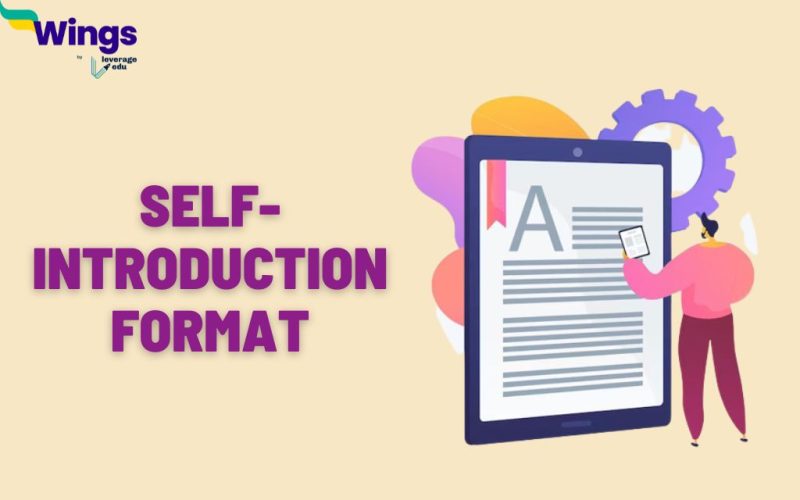When it comes to introducing ourselves, many of us feel a bit nervous or unsure about where to start. However, a well-crafted self-introduction can be a powerful tool for making a good first impression and establishing meaningful connections with others. In this blog, we’ll explore the format for a successful self-introduction in the interview and provide some tips for crafting a memorable introduction that showcases your strengths, weaknesses and personality.
This Blog Includes:
Format for a Self-Introduction
To write an impactful self-introduction, make sure to follow a set format of self-introduction. These are some of the components of a perfect self-introduction:
Greeting: Start by greeting your audience or the person you introduce yourself to. A simple “hello” or “hi” will suffice, but you can also use a more formal greeting if appropriate.
Name: State your name clearly and confidently. If you have a difficult or unusual name, consider providing a pronunciation guide to help others say it correctly.
Background: Share information about yourself that gives others a sense of who you are. This can include your profession, educational background, or hobbies and interests.
Accomplishments: Highlight any accomplishments or achievements that you’re proud of. This can help establish your credibility and expertise in your field.
Skills and strengths: Mention any skills or strengths that you possess that are relevant to the situation or context. This can help others see how you can add value or contribute to a project or conversation.
Goals and aspirations: Share any goals or aspirations that you have, either personally or professionally. This can help others understand what motivates and drives you.
Closing: End your introduction with a polite and friendly closing, such as “Nice to meet you” or “Thank you for having me.”
Also Read – How to Say Hello in Different Indian Languages
Examples of Self-Introduction
These are some of the samples according to the self-introduction format:
- My name is Sarah. I have a degree in business administration and I am currently working as a marketing manager in a software company. In my current role, I’ve led successful campaigns that have increased our company’s visibility and sales. My strengths include strategic planning, creativity and communication. Outside of work, I enjoy reading and trying new restaurants.
- Hi, my name is Ayush. I am a recent graduate of XYZ University, where I studied Mechanical Engineering. During my time there, I was part of a team that designed and built a solar-powered car. My skills include problem-solving and project management. I am looking for opportunities to apply engineering skills and make a positive impact in the world.
Tips for Writing a Good Self-Introduction
Follow the below-mentioned tips to write a memorable self-introduction while following the self-introduction format:
Keep It Concise: A self-introduction shouldn’t be too long or detailed. Keep it to one or two minutes, and focus on the most important and relevant information.
Tailor it to your audience: Consider the context and audience when crafting your self-introduction. For example, if introducing yourself to a potential employer, focus on your professional background and accomplishments.
Use positive language: Use positive language and avoid negative or self-deprecating comments. This can help you come across as confident and competent.
Be authentic: Finally, be true to yourself and your personality. A genuine and authentic self-introduction with all your qualities can help establish a connection and build trust with others.
Also Read – HR Interview Questions and Answers You Must Know
FAQs
A self-introduction should be brief, typically no longer than 1-2 minutes. It should focus on the most important and relevant information about yourself.
A self-introduction should include your name, background, accomplishments, skills and strengths, goals and aspirations, and a polite closing.
The tone of your self-introduction should depend on the context and audience. If you are introducing yourself in a professional setting, a more formal tone may be appropriate. However, if you are introducing yourself in a social setting, a more casual and friendly tone may be more appropriate.
To make your self-introduction more engaging, you can use storytelling techniques or humour. You can also try to tailor your introduction to your audience and use positive language to convey confidence and competence.
Introducing yourself can be a nerve-wracking experience, but with the right format and some practice, it can be a powerful tool for establishing meaningful connections with others. We hope that this article has helped you in what ways you want.
For the latest blogs on Interview Preparation, Careers and more, follow the Leverage Edu website and YouTube channel.
 One app for all your study abroad needs
One app for all your study abroad needs














 45,000+ students realised their study abroad dream with us. Take the first step today.
45,000+ students realised their study abroad dream with us. Take the first step today.

